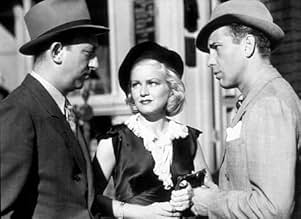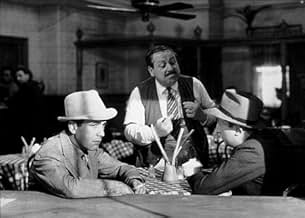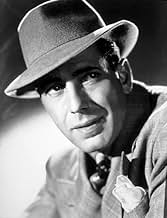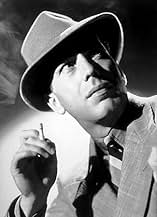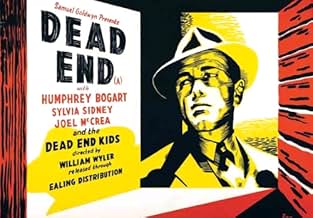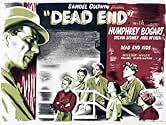VALUTAZIONE IMDb
7,2/10
9201
LA TUA VALUTAZIONE
Le vite di due giovani, un uomo e una donna, un famigerato gangster e un gruppo di ragazzi di strada, convergono un giorno in una baraccopoli di New York.Le vite di due giovani, un uomo e una donna, un famigerato gangster e un gruppo di ragazzi di strada, convergono un giorno in una baraccopoli di New York.Le vite di due giovani, un uomo e una donna, un famigerato gangster e un gruppo di ragazzi di strada, convergono un giorno in una baraccopoli di New York.
- Regia
- Sceneggiatura
- Star
- Candidato a 4 Oscar
- 1 vittoria e 4 candidature totali
Leo Gorcey
- Spit
- (as Leo B. Gorcey)
Recensioni in evidenza
Considering all the talent involved, it was hardly surprising to find this a first rate movie. Didn't you want to slap Bogart around ... well, that is actually what compelled me to make this entry. Among the handful of superlative cameo (say 2 to 8 minutes in length)performances I have seen in my 40 plus years of movie-going, Dead End features one of them.
Marjorie Main, almost as unlikely a film character (think Ma Kettle!) as one could imagine, turned in what I consider a masterpiece. Read that she repeated her stage role, and wow, that slap, that dialog and that role. Bravo!
Marjorie Main, almost as unlikely a film character (think Ma Kettle!) as one could imagine, turned in what I consider a masterpiece. Read that she repeated her stage role, and wow, that slap, that dialog and that role. Bravo!
Now here's a fascinating world from the late 1930s, where they're not really angels but they still have faces dirty, where the rich butt up with poor, as they wander through their backdoor, and the disconnect provokes and displeases. The kids of the Dead End are always causing trouble, as they live their lives in a ghetto like bubble, observed by 'Baby Face' Martin, who's returned to be disheartened, this villain prefers knife over knuckle. You're left with a feeling that the worlds on the cusp, a self-destructive nature that might leave it in dust, but four years later a falcon will rise, and a year after that a white house will surprise.
The main credit of "Dead End" lies in the stunning visual beauties. The studio reproduction of a New York slum is really magnificent, worth of other major achievements of the same kind, like, say, the set of "Rear Window". A true joy for the eyes. The work of the camera and William Wyler's direction are outstanding, as well. And, of course, the job of the cast is great. Bogart, still in the role of the villain, McCrea and Sylvia Sidney are excellent, and save their rather straightforward characters and lines. In my opinion, the best one is Claire Trevor, in the small part of the lost girl. I normally dislike kids on the screen, but I must concede that here they give great performances, playing the gang of street-boys.
The story is conventional, with a noble message, but few and predictable twists. The script is often clumsy and preachy. Luckily enough, the director gives a quick pace to the narration and inserts a number of humoristic touches. There's a main flaw in the plot: I think that, even in the States of the 1930s, a common citizen couldn't freely shoot a gangster.
Anyway, I've found in the screen-play an interesting and modern theme, namely the psychological ambiguity of some characters, whom even the all-knowing viewer cannot fully understand. For instance, Claire Trevor is apparently the cliche disgraced girl, the innocent victim of poverty, lack of opportunities, social injustice. To end as a prostitute is her unavoidable doom... But, when her former boy-friend Bogie gives some money to help her, she makes the horribly vulgar request of "twenty more bucks"... with a grimace worth of a hardened prostitute (great stuff by Trevor!). So we see that, after all, perhaps that girl is not so innocent as she pretends to be... And what about Drina's brother, the leader of the street-boys? The audience is perfectly aware that, in spite of his whining, weeping self-apologies (when he's in dire straits), the boy is a REAL criminal. We see that he deliberately harms people, steals, brutally thrashes the rich kid, wants to slash his gang-mate. And he just mocks his affectionate sister and his friend McCrea when, in tears, he cries that he's good, that he didn't intend to harm, and all that. So, are we supposed to feel sympathy for this hideous boy? Interesting ambiguity, which creates a fine artistic effect... perhaps beyond the actual intentions of the writer Lillian Hellman.
All in all, we may forgive the defects of the movie. it is worth seeing "Dead End", enjoying the beauty of the set and the work of director and actors.
The story is conventional, with a noble message, but few and predictable twists. The script is often clumsy and preachy. Luckily enough, the director gives a quick pace to the narration and inserts a number of humoristic touches. There's a main flaw in the plot: I think that, even in the States of the 1930s, a common citizen couldn't freely shoot a gangster.
Anyway, I've found in the screen-play an interesting and modern theme, namely the psychological ambiguity of some characters, whom even the all-knowing viewer cannot fully understand. For instance, Claire Trevor is apparently the cliche disgraced girl, the innocent victim of poverty, lack of opportunities, social injustice. To end as a prostitute is her unavoidable doom... But, when her former boy-friend Bogie gives some money to help her, she makes the horribly vulgar request of "twenty more bucks"... with a grimace worth of a hardened prostitute (great stuff by Trevor!). So we see that, after all, perhaps that girl is not so innocent as she pretends to be... And what about Drina's brother, the leader of the street-boys? The audience is perfectly aware that, in spite of his whining, weeping self-apologies (when he's in dire straits), the boy is a REAL criminal. We see that he deliberately harms people, steals, brutally thrashes the rich kid, wants to slash his gang-mate. And he just mocks his affectionate sister and his friend McCrea when, in tears, he cries that he's good, that he didn't intend to harm, and all that. So, are we supposed to feel sympathy for this hideous boy? Interesting ambiguity, which creates a fine artistic effect... perhaps beyond the actual intentions of the writer Lillian Hellman.
All in all, we may forgive the defects of the movie. it is worth seeing "Dead End", enjoying the beauty of the set and the work of director and actors.
It offers a vivid portrait of people caught up in a continual fight to somehow satisfy themselves despite the oppressive environment that seemed to quiet their every attempt
Joel McCrea is a frustrated architect who dreams of tearing down the slums and Sylvia Sidney portrays a shopgirl struggling for identity and meaning in her life, a life made even more complicated by having to look after her brother (Billy Halop). The boy idolizes the decadent Bogart, an excessive admiration shared by the rest of the Dead End Kids, here recreating their original Broadway roles with noisy good humor
Opposing these idealists is their real threat, Bogart, an assassin named Baby Face Martin Bogart is impolitely rejected by a mother (Marjorie Main) who hates him and an ex-girl friend (Claire Trevor) who leaves him bitter and disillusioned when he discovers that she has become a hooker
Rebuked by those he had been sentimental enough to want to visit, he rapidly reverts to represent beforehand and plans a kidnapping in order to rescue something from the consumed affair
"Dead End" remains one of Bogart's best films, where the actor proves that he is capable of handling difficult material with considerable skill
Joel McCrea is a frustrated architect who dreams of tearing down the slums and Sylvia Sidney portrays a shopgirl struggling for identity and meaning in her life, a life made even more complicated by having to look after her brother (Billy Halop). The boy idolizes the decadent Bogart, an excessive admiration shared by the rest of the Dead End Kids, here recreating their original Broadway roles with noisy good humor
Opposing these idealists is their real threat, Bogart, an assassin named Baby Face Martin Bogart is impolitely rejected by a mother (Marjorie Main) who hates him and an ex-girl friend (Claire Trevor) who leaves him bitter and disillusioned when he discovers that she has become a hooker
Rebuked by those he had been sentimental enough to want to visit, he rapidly reverts to represent beforehand and plans a kidnapping in order to rescue something from the consumed affair
"Dead End" remains one of Bogart's best films, where the actor proves that he is capable of handling difficult material with considerable skill
In "Dead End" the nominal stars are Sylvia Sidney and Joel McCrea but it is the supporting players that steal the picture. Great performances are turned in by the Dead End Kids (Billy Halop, Huntz Hall, Bobby Jordan, Leo Gorcey, Bernard Punsley), Humphrey Bogart, Claire Trevor and Marjorie Main. It also benefits greatly from the direction of William Wyler who keeps the story moving and makes the characters interesting.
"Dead End" was originally produced on the Broadway stage. The Dead End Kids re-enact their Broadway roles. The story takes place on the banks of the East River in New York where posh apartment buildings co-habit the neighborhood with the tenement slums. The plot centers on the activities of the people of the neighborhood one summer's day.
Dave Connell (McCrea) is a struggling architect looking for his big break. Drina (Sidney) is a struggling shop clerk who is involved in a labor dispute and hopes one day to be able to leave the neighborhood. Gangster "Baby Face" Martin (Bogart) returns to his childhood haunts hoping to see his mother (Main) and hook up with his old girlfriend Francey (Trevor). Hanging around the wharf are a group of teenage toughs (The Dead End Kids) one of whom, Tommy (Halop) is the brother of Drina.
The boys taunt rich kid Philip Griswald (Charles Peck) and lure him down to the street. There he is beaten up by the boys. His father (Minor Watson) is highly influential man who insists on justice for his son. One of the boys, "Spit" squeals on his pal and Tommy is arrested after stabbing Mr. Griswald in the hand.
Meanwhile Martin goes to see his mother and is shocked when she slaps him and calls him a murderer. Martin's pal "Hunk" (Allen Jenkins) locates Francey and arranges for her to come meet "Baby Face". Martin is doubly shocked when he learns that his former love has pursued a career on the streets.
During an altercation with Dave over the influencing of the boys, Martin stabs him and throws him into the river, leaving him for dead. Martin then hatches a plot to kidnap the rich kid Philip Griswald. But Dave returns, confronts Martin and..............
This film is arguably Bogey's best film of the 1930s. Oddly enough, it was made on loan out to Samuel Goldwyn. His expressions of surprise and disgust after meeting with his mother and Francey are a treasure to watch. Trevor's performance, however brief, was moving enough to garner her a best supporting actress Oscar nomination. Marjorie Main also only appears briefly but evokes great sympathy in her role as the tragic Mrs. Martin.
The Dead End Kids to a man turn in what are the best performances in the film. They would go on to appear in a series of Warner Bros films in the next two years before moving into several "B" series in the 40s and 50s. Also, look for Ward Bond as the doorman to the rich apartment building and Don "Red" Barry as an abalones doctor.
An excellent film.
"Dead End" was originally produced on the Broadway stage. The Dead End Kids re-enact their Broadway roles. The story takes place on the banks of the East River in New York where posh apartment buildings co-habit the neighborhood with the tenement slums. The plot centers on the activities of the people of the neighborhood one summer's day.
Dave Connell (McCrea) is a struggling architect looking for his big break. Drina (Sidney) is a struggling shop clerk who is involved in a labor dispute and hopes one day to be able to leave the neighborhood. Gangster "Baby Face" Martin (Bogart) returns to his childhood haunts hoping to see his mother (Main) and hook up with his old girlfriend Francey (Trevor). Hanging around the wharf are a group of teenage toughs (The Dead End Kids) one of whom, Tommy (Halop) is the brother of Drina.
The boys taunt rich kid Philip Griswald (Charles Peck) and lure him down to the street. There he is beaten up by the boys. His father (Minor Watson) is highly influential man who insists on justice for his son. One of the boys, "Spit" squeals on his pal and Tommy is arrested after stabbing Mr. Griswald in the hand.
Meanwhile Martin goes to see his mother and is shocked when she slaps him and calls him a murderer. Martin's pal "Hunk" (Allen Jenkins) locates Francey and arranges for her to come meet "Baby Face". Martin is doubly shocked when he learns that his former love has pursued a career on the streets.
During an altercation with Dave over the influencing of the boys, Martin stabs him and throws him into the river, leaving him for dead. Martin then hatches a plot to kidnap the rich kid Philip Griswald. But Dave returns, confronts Martin and..............
This film is arguably Bogey's best film of the 1930s. Oddly enough, it was made on loan out to Samuel Goldwyn. His expressions of surprise and disgust after meeting with his mother and Francey are a treasure to watch. Trevor's performance, however brief, was moving enough to garner her a best supporting actress Oscar nomination. Marjorie Main also only appears briefly but evokes great sympathy in her role as the tragic Mrs. Martin.
The Dead End Kids to a man turn in what are the best performances in the film. They would go on to appear in a series of Warner Bros films in the next two years before moving into several "B" series in the 40s and 50s. Also, look for Ward Bond as the doorman to the rich apartment building and Don "Red" Barry as an abalones doctor.
An excellent film.
Lo sapevi?
- QuizWilliam Wyler gave Claire Trevor an old purse and broken high heel shoes. He had her minimize her make-up and ordered her not to comb her hair when she got up in the morning. He wanted her to look like the downtrodden character she was playing.
- BlooperBaby Face Martin suddenly appears from nowhere and is leaning against a railing as the boys are fighting.
- Curiosità sui creditiOpening credits prologue: Every street in New York ends in a river. For many years the dirty banks of the East River were lined with the tenements of the poor. Then the rich, discovering that the river traffic was picturesque, moved their houses eastward. And now the terraces of these great apartment houses look down into the windows of the tenement poor.
- ConnessioniFeatured in AFI Life Achievement Award: A Tribute to William Wyler (1976)
- Colonne sonoreBoo-Hoo
(1937) (uncredited)
Music by Carmen Lombardo and John Jacob Loeb
Lyrics by Edward Heyman
Played at the upstairs party and sung by Huntz Hall in the street
I più visti
Accedi per valutare e creare un elenco di titoli salvati per ottenere consigli personalizzati
- How long is Dead End?Powered by Alexa
Dettagli
Botteghino
- Budget
- 300.000 USD (previsto)
- Tempo di esecuzione1 ora 33 minuti
- Colore
- Proporzioni
- 1.37 : 1
Contribuisci a questa pagina
Suggerisci una modifica o aggiungi i contenuti mancanti

Divario superiore
By what name was Strada sbarrata (1937) officially released in India in English?
Rispondi

